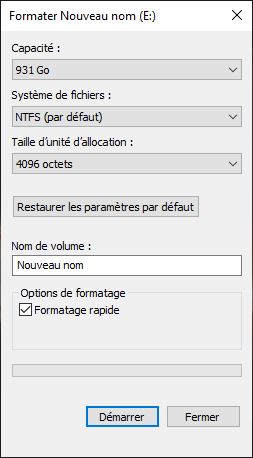A computer scientist who worked on Windows, David Plummer, shared an anecdote about the operating system. The tool dedicated to formatting was initially developed in a provisional version, which should have been updated subsequently. However, the update never took place. And since then, the blunder has remained.
It’s the kind of story that any computer scientist could certainly tell, as an anecdote. A forgotten piece of code, a easter egg hidden in an instruction, a comment that is out of the ordinary. The tech odyssey is full of unexpected little stories — we see it, for example, in the names of companies.
On March 25, Dave William Plummer happened to delivered to a confession on X (formerly Twitter). Its name probably doesn’t mean anything to you. However, if you use the Windows operating system, you have probably already encountered his work. His contributions to tech are such that he eventually got his own Wikipedia page.
Among its great achievements, let us mention two: the Windows task manager (it is via this dialog box that you kill an active process, if an application no longer responds), and support on Windows for the ZIP format which is used for data compression, to save some space and group files into an archive.

We also owe him the famous dialog box about formatting in Windows. This function has the effect of erasing all the contents of a storage medium accessible by the OS, such as a hard drive or a USB key. If you have already used this tool, David Plummer’s work is absolutely familiar to you.
However, this formatting utility is found in Windows due to a misunderstanding. It was not intended to have this look and layout. The dialog box that is currently present in the operating system was intended to be an interim solution, pending a more elegant, more orderly approach.
The tool that needed to be updated and was forgotten
This is precisely what David Plummer’s anecdote tells us. At the time when the computer scientist looked into the subject, at the end of 1994 according to him, Microsoft was launched into a vast project: it involved transposing the myriad lines of code from Windows 95 to NT (acronym for New Technology) , a new family of Windows operating systems.
“ Formatting was one of the areas where Windows NT was different enough from Windows 95 that we had to create a custom user interface “, he says. For the public, the Windows NT era mainly appeared with XP, released in October 2001 — and sometimes with Windows 2000, launched in December 1999.
David Plummer then lists all the options and parameters to consider when performing a formatting operation: choice of file system, allocation unit size, name to give to the storage space, choice or not of a quick formatting, or resetting the settings, to find those defined by default.
The user only had to launch the operation with the “Start” button or close the dialog box, with the traditional cross at the top right or via the “Close” button. Generally, the public had to decide mainly on the file system (FAT vs NTFS), the first being adapted for the Windows 9x family, the second for NT.


“ I took a sheet of paper and wrote down all the options and choices you could make regarding formatting a disk “, he said. “ Then I pulled out the Visual C++ software and used the resource editor to create a simple stack of all the choices to be made, in the approximate order they needed to be made. »
He recognizes it: all this was arbitrary, because it must above all be very temporary. Porting work was underway between two generations of OS and this stopgap should have been replaced soon. “ It wasn’t very elegant, but it was enough until a sleek user interface came along “, he remembers.
Obviously, the need to update the utility was lost along the way, since it is still this dialog window that we use thirty years later. We still find it in Windows 11, released in October 2021. History does not tell the causes of this mess, fortunately without any unfortunate consequences.
Will the emergence of this story be an opportunity to clean up the formatting tool when Windows 12 arrives? Maybe. But above all it is an opportunity for David Plummer to send a reminder: we must be wary of temporary solutions in the code. They tend to be forgotten and become permanent.
Subscribe for free to Artificielles, our newsletter on AI, designed by AIs, verified by Numerama!
